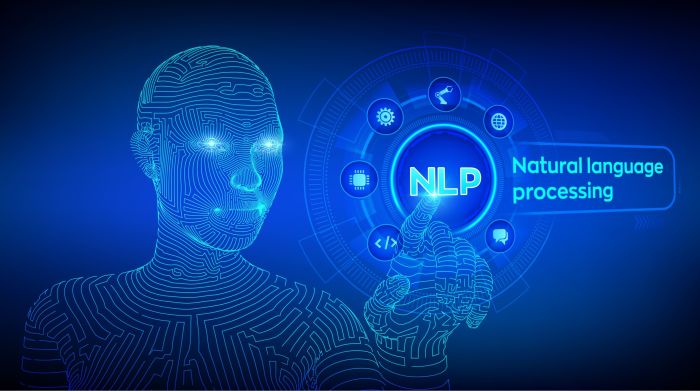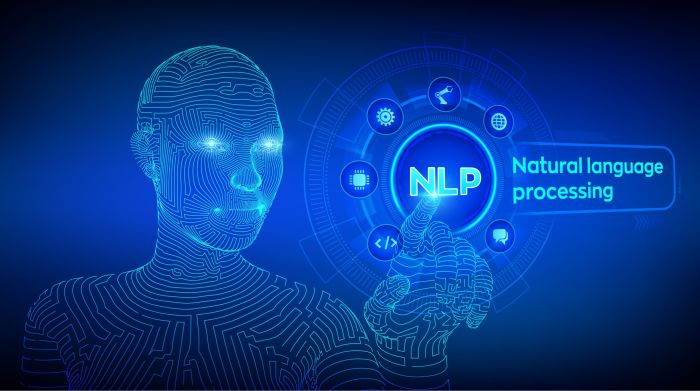
What is natural language processing sets the stage for this enthralling narrative, offering readers a glimpse into a story that is rich in detail with personal blog style and brimming with originality from the outset. Imagine a world where computers can understand and respond to human language just like we do.
This isn’t science fiction; it’s the reality of natural language processing (NLP), a field that’s revolutionizing how we interact with technology.
NLP is the ability of computers to understand, interpret, and generate human language. It’s the key behind everything from voice assistants like Siri and Alexa to spam filters that keep our inboxes clean. NLP empowers machines to process vast amounts of text and speech data, extracting valuable insights and automating tasks that were once thought to be exclusively human.
Introduction to Natural Language Processing (NLP)
In the digital age, where information flows relentlessly, understanding and interpreting human language has become paramount. Natural Language Processing (NLP) emerges as a transformative field that bridges the gap between humans and computers, enabling machines to comprehend, interpret, and generate human language.
NLP empowers computers to process and understand the nuances of human language, unlocking a world of possibilities across diverse industries.
Core Principles and Objectives of NLP
NLP aims to equip computers with the ability to understand and manipulate human language, encompassing a range of tasks that mimic human cognitive abilities. The core principles of NLP revolve around:
- Natural Language Understanding (NLU):This involves enabling computers to understand the meaning and context of human language. NLU techniques analyze the structure, syntax, and semantics of text to extract information and identify relationships between words and phrases. For instance, NLU algorithms can determine the sentiment expressed in a piece of text, identify key entities mentioned, or understand the intent behind a user query.
- Natural Language Generation (NLG):NLG focuses on enabling computers to generate human-like text. NLG algorithms utilize knowledge bases and language models to create coherent and grammatically correct sentences, paragraphs, and even entire documents. Examples of NLG applications include generating summaries of news articles, creating personalized reports, or composing creative writing pieces.
Real-World Applications of NLP
NLP has revolutionized various industries, transforming the way we interact with technology and information. Here are some prominent examples:
- Customer Service:Chatbots powered by NLP are increasingly employed to provide instant customer support, answer frequently asked questions, and resolve issues efficiently. NLP enables chatbots to understand customer queries, provide relevant responses, and even engage in natural conversations.
- Search Engines:Search engines utilize NLP to understand user queries, analyze web content, and deliver relevant search results. NLP techniques help to interpret the intent behind search queries, identify synonyms and related terms, and rank web pages based on their relevance.
- Social Media Analysis:NLP plays a crucial role in analyzing social media data, extracting insights into public sentiment, identifying trends, and understanding customer preferences. By analyzing user posts, comments, and interactions, NLP algorithms can provide valuable information for businesses and organizations.
- Machine Translation:NLP powers machine translation systems, enabling the seamless translation of text from one language to another. Machine translation algorithms use statistical models and neural networks to analyze and translate text, bridging language barriers and facilitating global communication.
- Healthcare:NLP is transforming healthcare by assisting in medical diagnosis, drug discovery, and patient care. NLP algorithms can analyze medical records, identify patterns in patient data, and generate personalized treatment plans.
- Education:NLP is being used to create personalized learning experiences, provide intelligent tutoring systems, and assess student performance. NLP algorithms can analyze student responses, identify learning gaps, and recommend appropriate learning materials.
Key Concepts in NLP: What Is Natural Language Processing
Natural language processing (NLP) is a field of computer science that focuses on enabling computers to understand, interpret, and generate human language. At its core, NLP relies on a set of fundamental concepts that underpin its ability to process and analyze text data.
Natural language processing (NLP) is a field of computer science that focuses on enabling computers to understand and process human language. It’s like giving computers the ability to “read” and “write” like we do. Imagine a world where you can chat with your phone like a friend, or where your computer can automatically summarize news articles for you.
This kind of magic is made possible by NLP, and with the Thomas Sabo “Experience Magic Week” offering a fantastic opportunity to find the perfect Christmas gift , you can add a touch of magic to your holiday season. NLP is constantly evolving, so who knows what exciting new possibilities it will bring in the future!
These concepts provide the framework for understanding how NLP systems work and the challenges they face.
Language Modeling
Language modeling is a fundamental concept in NLP that deals with predicting the probability of a sequence of words. It plays a crucial role in various NLP tasks, such as machine translation, speech recognition, and text generation.
- N-grams: N-grams are sequences of n consecutive words in a text. They are used to represent the statistical relationships between words in a language. For example, the bigram “natural language” is a sequence of two words that frequently occur together.
The probability of a word given its preceding n-1 words is calculated based on the frequency of the n-gram in a corpus.
- Statistical Language Models: Statistical language models use probabilistic methods to predict the probability of a sequence of words. They are trained on large amounts of text data to learn the statistical patterns of language. The model can then be used to generate text, predict the next word in a sequence, or evaluate the quality of a generated text.
Syntax and Semantics
Syntax and semantics are two crucial aspects of language that influence how NLP systems understand and interpret text.
- Syntax: Syntax refers to the grammatical structure of a sentence. It defines the rules that govern how words are combined to form meaningful phrases and sentences. NLP systems use syntactic analysis to parse sentences and identify the relationships between words.
Natural language processing (NLP) is a field of computer science that focuses on enabling computers to understand and interact with human language. NLP is used in a wide range of applications, from chatbots to search engines. It’s even used to analyze customer reviews and help you find the best deals on things like electrical brands black friday.
So, the next time you’re looking for a great deal on a new appliance, remember that NLP is working behind the scenes to make your shopping experience easier and more efficient.
This information is crucial for understanding the meaning of a sentence and for tasks such as machine translation and question answering.
- Semantics: Semantics deals with the meaning of words and sentences. It involves understanding the relationships between words and their contexts. NLP systems use semantic analysis to interpret the meaning of text, identify entities and relationships, and understand the underlying intent of the text.
Lexical Analysis
Lexical analysis is the process of breaking down text into meaningful units, such as words, punctuation marks, and other symbols. It is the first step in most NLP tasks and plays a crucial role in understanding the structure and meaning of text.
- Tokenization: Tokenization is the process of dividing a text into individual units called tokens. These tokens can be words, punctuation marks, or other symbols. Tokenization is essential for subsequent NLP tasks, such as part-of-speech tagging and named entity recognition.
- Stemming and Lemmatization: Stemming and lemmatization are techniques used to reduce words to their base forms. Stemming involves removing suffixes from words, while lemmatization aims to find the dictionary form of a word. These techniques help to reduce the number of unique words in a text and improve the accuracy of NLP tasks.
Techniques and Algorithms in NLP

Natural Language Processing (NLP) leverages various techniques and algorithms to understand and process human language. These approaches have evolved over time, from rule-based systems to sophisticated statistical methods and deep learning models. This section explores these techniques and their underlying algorithms, highlighting their strengths and limitations.
Rule-Based Systems
Rule-based systems, also known as expert systems, rely on predefined rules and patterns to analyze and interpret text. These rules are typically hand-crafted by experts, capturing specific linguistic knowledge and relationships. For instance, a rule-based system for sentiment analysis might identify positive sentiment in sentences containing words like “great,” “amazing,” or “excellent.” Similarly, rules could be defined to recognize grammatical structures or identify named entities.
Natural language processing (NLP) is a fascinating field that allows computers to understand and interact with human language. It’s used in everything from chatbots to translation services. Speaking of interactions, I recently hosted a New Year’s Eve wine bar for friends, and I learned a valuable lesson about chilling wine.
I used a DIY ice bucket, as described in this article on chilled wines and DIY ice buckets , and it was a lifesaver! Back to NLP, the possibilities are endless, and I’m excited to see how it continues to evolve and shape our world.
- Advantages:Rule-based systems are often transparent and easy to understand, allowing for interpretability. They are also relatively efficient and can handle specific tasks effectively.
- Limitations:Rule-based systems are brittle and require extensive manual effort to create and maintain. They struggle with ambiguity and complex language structures, limiting their adaptability to new domains or languages.
Statistical Methods
Statistical methods employ probabilistic models to analyze language data and learn patterns from large text corpora. These methods rely on the frequency of words, phrases, and grammatical structures to make predictions and inferences. One prominent example is the Hidden Markov Model (HMM), used for tasks like part-of-speech tagging and speech recognition.
HMMs represent a sequence of hidden states (e.g., grammatical tags) based on observable words. Another popular statistical approach is Conditional Random Fields (CRFs), which model the relationships between variables in a sequence, considering the context of surrounding words. CRFs are commonly used for tasks like named entity recognition and chunking.
- Advantages:Statistical methods are data-driven and can adapt to new data, making them more robust than rule-based systems. They often achieve high accuracy, particularly when trained on large datasets.
- Limitations:Statistical methods can be computationally expensive and require significant training data. They may struggle with rare words or complex linguistic phenomena, requiring further refinements.
Deep Learning Approaches
Deep learning approaches utilize artificial neural networks with multiple layers to learn complex representations of language data. These models can capture intricate relationships and patterns in text, leading to improved performance in various NLP tasks. Recurrent Neural Networks (RNNs), specifically Long Short-Term Memory (LSTM) networks, have proven highly effective for tasks involving sequential data, such as machine translation and text summarization.
RNNs maintain a memory of past information, enabling them to process sequences of words effectively.Another deep learning approach is the Transformer model, which relies on attention mechanisms to capture long-range dependencies in text. Transformers have achieved state-of-the-art results in tasks like machine translation, question answering, and text generation.
- Advantages:Deep learning models are highly adaptable and can learn complex language structures, leading to improved accuracy in various NLP tasks. They can handle large amounts of data and learn from diverse sources.
- Limitations:Deep learning models require significant computational resources for training and can be computationally expensive to deploy. They are often black boxes, making it difficult to interpret their decision-making processes.
Applications of NLP
Natural Language Processing (NLP) has revolutionized how we interact with computers and data. It enables machines to understand, interpret, and generate human language, opening up a wide range of applications across various domains. This section explores some of the key applications of NLP, categorized by their core functionalities.
Text Analysis & Understanding
Text analysis and understanding applications leverage NLP techniques to extract meaningful insights from textual data. These applications are essential for businesses, researchers, and individuals seeking to understand the sentiment, topics, and key information within large volumes of text.NLP plays a crucial role in sentiment analysis, a technique used to determine the emotional tone or opinion expressed in text.
By analyzing words, phrases, and their context, NLP algorithms can identify whether a piece of text expresses positive, negative, or neutral sentiment. This information is invaluable for businesses to understand customer feedback, track brand reputation, and gauge public opinion on products or services.Topic modeling is another powerful application of NLP that helps identify the underlying themes or topics present in a collection of documents.
By analyzing word frequencies and co-occurrences, NLP algorithms can discover hidden patterns and relationships within text, providing insights into the key subjects discussed. This is particularly useful for researchers, journalists, and analysts who need to make sense of large datasets of text, such as news articles, scientific papers, or social media posts.Text summarization leverages NLP to create concise summaries of longer texts, preserving the most important information while reducing redundancy.
NLP algorithms can identify key sentences, extract important concepts, and generate summaries that accurately reflect the content of the original text. This is valuable for individuals who need to quickly grasp the essence of lengthy documents, such as research papers, news articles, or legal documents.
Machine Translation
Machine translation, the automatic conversion of text from one language to another, has made communication across language barriers easier and more accessible. NLP techniques are at the heart of machine translation systems, enabling them to understand the nuances of different languages and generate accurate and fluent translations.Machine translation has evolved significantly over the years, moving from rule-based systems to statistical and neural machine translation models.
Statistical machine translation (SMT) relies on statistical models trained on large bilingual corpora, using probability distributions to predict the most likely translation for a given word or phrase. While SMT has achieved significant progress, it can struggle with complex sentences and idiomatic expressions.Neural machine translation (NMT) emerged as a more sophisticated approach, utilizing deep learning techniques to learn the complex relationships between languages.
NMT models are trained on massive datasets of parallel text, allowing them to capture the nuances of language and generate more human-like translations. NMT has significantly improved the quality of machine translation, particularly for languages with limited resources.
Speech Recognition
Speech recognition, the process of converting spoken language into text, is a crucial application of NLP that enables computers to understand and process human speech. It involves a series of steps, starting with capturing the audio signal, followed by acoustic analysis to identify individual sounds, and finally, language modeling to interpret the sequence of sounds as words and sentences.Speech recognition has become ubiquitous in our daily lives, powering voice assistants like Siri and Alexa, dictation software, and speech-to-text applications.
It allows users to interact with devices hands-free, control their environments with voice commands, and transcribe spoken language for accessibility and documentation purposes.
Chatbots & Conversational AI
Chatbots and virtual assistants are increasingly popular, leveraging NLP to engage in natural conversations with users. These AI-powered systems use NLP techniques to understand the intent and context of user queries, retrieve relevant information, and generate responses that mimic human conversation.Building conversational AI systems that can understand and respond to human language naturally presents significant challenges.
NLP algorithms must be able to handle ambiguity, slang, and idiomatic expressions, while also maintaining context and consistency throughout the conversation.
Information Retrieval, What is natural language processing
Information retrieval, the process of finding relevant information from a collection of documents, is greatly enhanced by NLP techniques. NLP algorithms can analyze the content of documents, identify key terms, and understand user queries to retrieve the most relevant results.NLP plays a vital role in improving search engines, enabling them to understand the meaning behind user queries and provide more accurate and relevant results.
It also powers personalized recommendations and content filtering systems, tailoring the information presented to users based on their interests and preferences.
Challenges and Future Directions in NLP
Despite its remarkable progress, NLP still faces significant challenges, pushing researchers to explore innovative solutions and future directions. These challenges stem from the inherent complexity of human language, its inherent ambiguity, and the need to develop models that can understand and respond to nuances in human communication.
Explainable AI for NLP
Explainable AI (XAI) aims to provide insights into how NLP models make decisions, enhancing transparency and trust in these systems. Understanding the reasoning behind a model’s predictions is crucial, especially in critical applications like healthcare or finance. XAI techniques for NLP focus on making the decision-making process of these models more interpretable, enabling users to understand the logic behind their outputs.
Multilingual NLP
Developing NLP models that can effectively handle multiple languages is a major challenge. Multilingual NLP aims to bridge the language barrier, enabling communication and information access across diverse linguistic communities. This involves developing models that can understand and process multiple languages, translating text accurately, and adapting to the nuances of different languages.
For example, a multilingual NLP model could be used to translate news articles from different languages, enabling users to access information from around the world.
Low-Resource NLP
Building NLP models for languages with limited data poses a significant challenge. Low-resource NLP focuses on developing techniques for building effective NLP models for languages with scarce data resources. This is essential for preserving linguistic diversity and enabling NLP applications in under-resourced languages.
For example, researchers are exploring techniques like cross-lingual transfer learning, where knowledge from high-resource languages is transferred to low-resource languages, enabling the development of NLP models for languages with limited data.






